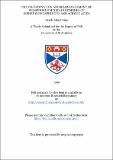Files in this item
The co-ordination and rearrangement of phosphorous mixed antihydrides of diphenylphosphinous and acrylic acids
Item metadata
| dc.contributor.advisor | Cole-Hamilton, D. J. (David John) | |
| dc.contributor.author | Irvine, Derek John | |
| dc.coverage.spatial | 315 p. | en_US |
| dc.date.accessioned | 2018-07-04T15:53:12Z | |
| dc.date.available | 2018-07-04T15:53:12Z | |
| dc.date.issued | 1990 | |
| dc.identifier.uri | https://hdl.handle.net/10023/14937 | |
| dc.description.abstract | The reactions of acrylic and vinylacetic acids with Ph₂PCl and Et₃N give Ph₂PO₂CCH=CH₂ (AAA) and Ph₂PO₂CCH₂CH=CH₂ (VAA) respectively. Both are found to undergo a facile rearrangment to give Ph₂PP(O)Ph₂ and AAA is also found to react with PPh₃ to give Ph₃P+-CH₂CH₂CO₂-. Their reaction (1 mole ligand to 1 mole Rh) with [(RhCl(1,₅ COD))₂], gives complexes of the form [(RhCl(L)₂], where L is AAA or VAA, in which the mixed anhydride ligands are bound via the phosphorus atom and the double bond. With AAA in a 1:2 mole reaction with [(RhCl(1,5 COD))₂] or a 1:1 mole reaction with [(RhCl(C₂H₄)₂)₂l, the major products are [(RhCl(AAA))₂ (Ph₂POPPh₂)] and [RhCl(AAA)₂], in which the mixed anhydride is bound as described above and the Ph₂POPPh₂ is a bridging ligand. Reaction (1:1) of AAA with [RhCl(PPh₃)₃] led to the formation of [RhCl(AAA)(PPh₃)]; anhydride coordination is as above and the phosphorus atoms are mutually trans. This complex is, however, found to revert back to [RhCl(PPh₃)₃] on standing. The (1:1) reaction with VAA produces [RhC1(PPh₃) (Ph₂PO₂CCH = CHMe)] (Ph₂PO₂CCH=CHMe = CAA), an example of a metal promoted double bond migration. Subsequent study shows that at ambient pressure and temperature this complex (with 3 butenoic, oleic and hexa-4-enoic acids) is involved in stoichiometric and not catalytic reactions. [RhCl(CAA)(PPh₃)] exhibits fluxionality at room temperature, 31p and 1H n.m.r, studies on this complex (₂₂₃-₂₆₃K) and on [Rh(CAA)(O₂CCH=CHMe)(PPh₃)] (₂₉₈K) has determined the fluxionality to be a fast exchange between the cis and trans forms and led to the calculation of the thermodynamic parameters for this process . The 1:₂ mole reaction of [RhCl(PPh₃)₃] and AAA gives lRhCl(PPh₃)(Ph₂POPPh₂)], which contains a chelate tetraphenyl diphosphoxane ligand (tpdp) formed via a metal promoted rearrangement of the AAA ligand. Subsequent reaction of this complex with TIPF₆ results in [Rh(PPh₃)₂(tpdp)][PF₆]. However if the [RhCl(PPh₃)(tpdp)] complex is not isolated, then the major product is [Rh(PPh₃)₃(Ph₃PCH₂CH₂CO₂)][PF₆]. Further tpdp complexes have been formed by refluxing Ph₂PP(O)Ph₂ with [RhCl(PPh₃)₃], [RuCl₂(PPh₃)₄] and [OsCl₂(PPh₃)₄] in THF. However the reaction of [RhCl(PPh₃)₃] with excess Ph₂PP(O)Ph₂ gives several products, one of which, namely [RhCl₂((PPh₂O)₂)H(PPh₂O)][HNEt₃], has been crystallographically characterised. The reaction (1:1) of [RuCl₂(PPh₃)₄] with Ph₂PO₂CCHCMe₂ (DAA) produces [RuCl₂(PPh₃)₂(DAA)], in which the mixed anhydride is bound via the phosphorus atom and the oxygen atom of the carbonyl group. The 1:1 mole reactions of CAA and AAA give similar complexes as minor products whilst the structure of the major product is, however, not known at this point in time. The 1:2 mole reaction was found to produce [RuCl₂(tpdp)(AAA)(PPh₃)] in which the mixed anhydride is bound via the phosphorus atom alone. | en_US |
| dc.language.iso | en | en_US |
| dc.publisher | University of St Andrews | |
| dc.subject.lcc | QD305.H7I8 | |
| dc.subject.lcsh | Alkenes | en |
| dc.title | The co-ordination and rearrangement of phosphorous mixed antihydrides of diphenylphosphinous and acrylic acids | en_US |
| dc.type | Thesis | en_US |
| dc.type.qualificationlevel | Doctoral | en_US |
| dc.type.qualificationname | PhD Doctor of Philosophy | en_US |
| dc.publisher.institution | The University of St Andrews | en_US |
This item appears in the following Collection(s)
Items in the St Andrews Research Repository are protected by copyright, with all rights reserved, unless otherwise indicated.

